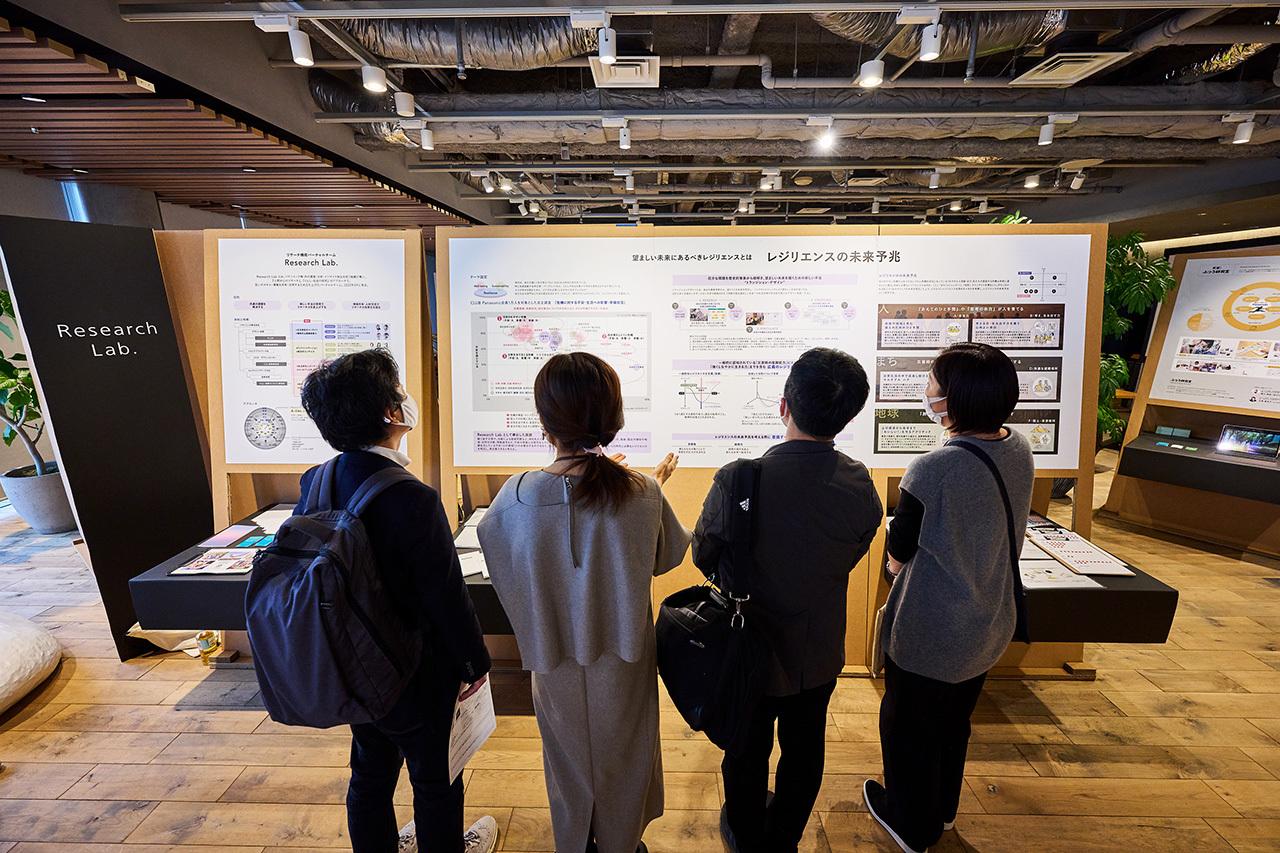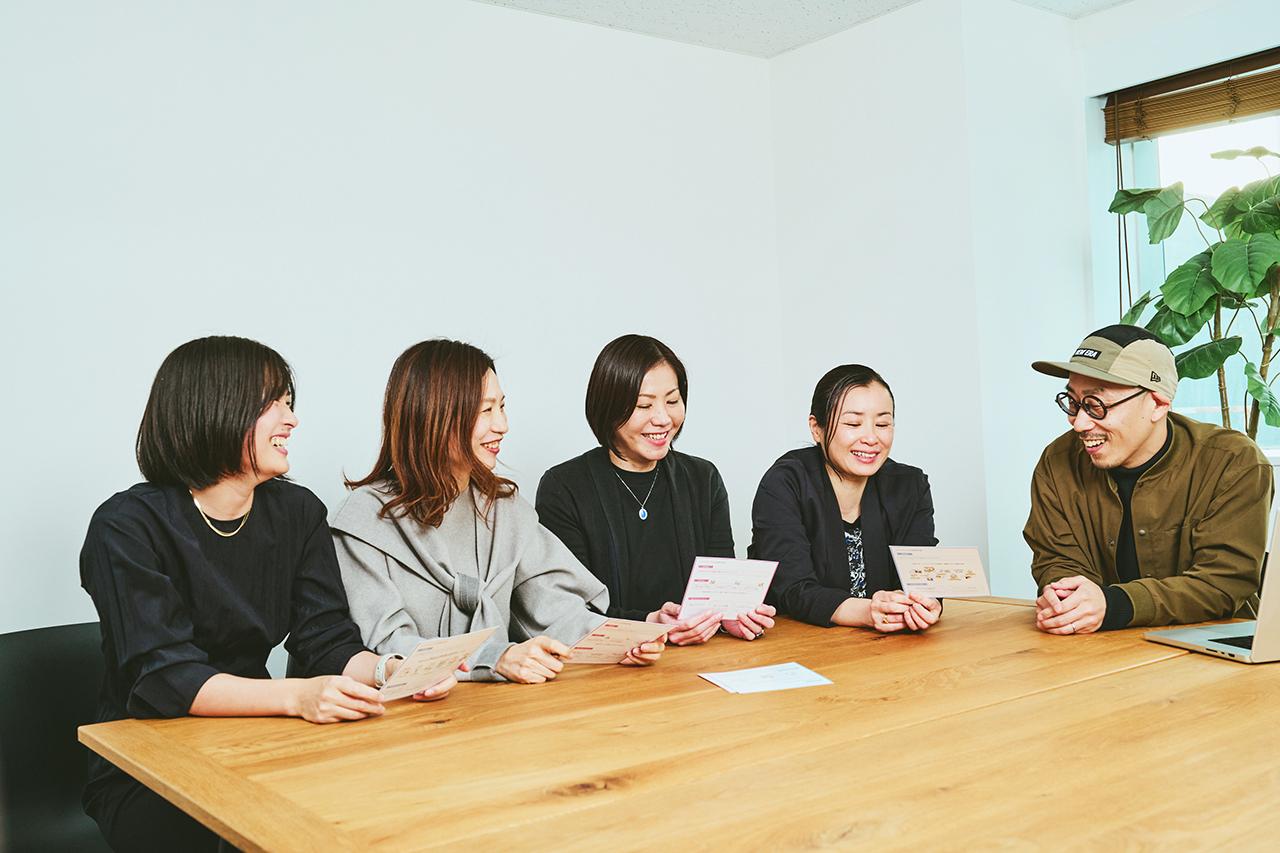Kozue Ito of Panasonic Future Creation Laboratory (left), Ms. Emi Fujikawa of Panasonic FLUX (middle), and Mr. Kazumasa Tsujimura (right), head of Infobahn’s design department “IDL[INFOBAHN DESIGN LAB.]”.
Panasonic is uncovering the diversifying perspectives and needs of consumers and taking on the challenge of creating a vision for a desirable future. The team “Research Lab” that conducts “design research” across the business is supporting the challenge from the ground up.
What exactly is cross-sectional research activity that makes full use of design research, which is said to be essential for design management?
Ms. Emi Fujikawa, a FLUX insight researcher from the Panasonic Design Division, who works as a member of the team, Mr. Kozue Ito, a consultant from the Future Creation Laboratory, and Infobahn’s design department IDL[INFOBAHN DESIGN]which supports the team’s activities. LAB.](hereinafter referred to as IDL), we asked Mr. Kazumasa Tsujimura, head of the department, about the reality and possibilities of design research.
A cross-sectional research team that transcends business boundaries
In the 1950s, Panasonic is known for establishing an in-house design department, the Advertising Department Design Section, which was extremely rare at the time. That tradition has been passed down, and Shigeo Usui, a former designer, has been appointed as an executive officer in 2021.
Research Lab was launched in 2022 to strengthen research activities.
“It wasn’t a formal organization, but rather a virtual team. Collaborating with researchers dispersed in various departments within the company would not create synergies and improve efficiency. I wonder if it will be possible to learn new methods and raise the overall level of research capabilities.I am active for that purpose.” (Mr. Ito)

Uniqueness of n=1 is a breakthrough
In the first place, design research surveys differ greatly in method and purpose from so-called marketing research.
Practice the trends that emerge from macro trend research and analysisThe aim is to have a fixed point dialogue with extreme users (extreme users with thorough behavioral patterns), analyze their values and lifestyles, and draw out insights (real intentions and latent needs).is.
For example, in the 2021 survey on sustainability and well-being conducted by FLUX, which Mr. Fujikawa belongs to, we listened to the voices of people in Japan and overseas who are practicing ethical lifestyles, and considered how the world would look to them. bottom. In addition, 10 researchers actually experienced an ethical life for about a month. I summarized the realizations and insights I got there.

Mr. Kazumasa Tsujimura, executive officer of Infobahn and head of the IDL division. After graduating from Tokyo University of Foreign Studies, he moved to the United States. He graduated from the Southern California Institute of Architecture (SCI_Arc) with a master’s degree in architecture. He joined Infobahn in 2014 after working in domestic and international architectural design offices and digital production. He leads product and service design based on design research. He is also engaged in interdisciplinary research across HCI (Human Computer Interaction), architecture and design research at the University of Tokyo Graduate School of Interdisciplinary Information Studies.
Mr. Tsujimura of IDL, who has studied and practiced design research, points out the importance of the process in design research.
“Nowadays, the area covered by ‘design’ is expanding, and it is not only the final output, but also the process and practical process. Design research is also important for the process.The “knowledge of design” obtained through the process of not only researching information but also putting it into practice and working with one’s own hands is connected to other processes and projects to create a new knowledge ecosystem.That’s right.
The personality of the target subject and the uniqueness of the selected artifact are also important, and even if n = 1, it can be a breakthrough in creating something new that will be accepted by other people.” (Tsujimura) )
Explore the resilience needed for a desirable future
Together with IDL, the research lab also challenged consideration of “resilience required for the future” using a technique called “transition design” that searches for a desirable future based on past events.
12 design researchers participated. Three workshops were held to decompose the abstract and unsolvable theme of “resilience,” into elements, and to discuss desirable future resilience.
Through the provision of materials and facilitation based on historical surveys, IDL questioned what the participants thought was “obvious”. It encourages thinking outside the box and helps teams create insight stories. After that, the research lab put together a proposal based on the findings from the workshop, and exhibited it at an internal conference held in December 2022.
Mr. Tsujimura, who proposed the introduction of transition design, describes its characteristics as follows.
“When we try to depict the future, we usually think about it from the perspective of a ‘forecast’ that looks ahead, but in Transition Design we think about going back in time. To the point where we can determine that we have gathered enough information to discern a drastic change in values, sometimes going back to the Edo period.
Rather than perceiving time linearly, we perceive the future as something that exists in the past as “circular time.” To that end, we will provide the necessary historical information while digging deeper into our thoughts.” (Mr. Tsujimura)

Emi Fujikawa, Insight Researcher at FLUX, Panasonic Design Headquarters. She has a master’s degree in interaction design from the Royal College of Art, UK. After engaging in healthcare-related user research and interaction design at PHILIPS Design in the Netherlands, she moved to India to deepen her knowledge of yoga, which she started as a hobby. She studied under Swami Dayananda Sarasvati ji at Arsha Vidya Gurukulam where she studied Vedanta and Sanskrit. After returning to Japan, she joined Panasonic in 2017 after working as a Global Innovation Design Lecturer at Keio University Graduate School of Media Design. In order to envision a desirable future where diversity is respected and no one is left behind, she engages in insight research from the point of view of consumers.
So what kind of information did IDL provide? Mr. Fujikawa said, “In transition design, it is necessary to refer to a huge number of historical events, but IDL does not simply collect historical events related to resilience, but presents interesting events that provide some inspiration. I gave it to you,” he says.
“For example, the Great Ansei Nankai Earthquake that occurred in 1854. At that time, it is said that many people lost their lives because they had to help their superiors. The legend that “if a tsunami occurs, it doesn’t matter if you run away separately,”) has permeated, and the case where each escaped by self-judgment and survived has attracted attention.” (Mr. Fujikawa)
From these two events, it is possible to consider that when making decisions necessary for survival, people’s sense of values regarding the presence of caring “others” and the strength of their presence changes.
“Though it is difficult to think about the future,The real thrill of transition design is drawing the future based on comparisons and considerations of past events and the present.It is.” (Mr. Fujikawa)

Mr. Kozue Ito, a consultant in the Knowledge & HCD Promotion Section, Future Creation Laboratory, Panasonic Design Division. Aiming to practice “value creation of products and services from the customer’s point of view”, she uses her knowledge of lifestyle research to implement vision design and solution proposals. Using desk research, quantitative and qualitative research, and interviews with experts, she promotes consulting that contributes to business activities, from analysis of people and lifestyles to extraction of business insights. She also develops a knowledge portal to support projects promoted by the Institute of Future Creation, such as providing market data and trend analysis from a researcher’s point of view.
“The method of going back to the past when thinking about the future was novel,” says Ito.
“A researcher must formulate a good hypothesis before conducting research.For that reason, it is effective to go back in timeI thought.
Re-examine what has not changed and what has changed, and write down what you should convey and what you notice on “Miro” (online whiteboard). Ultimately, it turned out to be a good hypothesis for the ideal future, and we were able to flesh it out into a proposal for the resilience necessary for the future.” (Mr. Ito)
Realizing changes in values
Panasonic has three departments: the design R&D team “FLUX” to which Mr. Fujikawa belongs, the “Future Creation Laboratory” where Mr. Ito is in charge of design and consulting functions, and the design studio “FUTURE LIFE FACTORY”.
Mr. Tsujimura said that he felt that having three future-oriented organizations was “a symbol of Panasonic’s progressiveness.”
“I don’t think there are many companies that take on the challenge of transition design, which is difficult to explain rationally. The entire company is promoting front-line projects that consider ‘things that are not here now.’ I think this is precisely because the management has a correct understanding of the possibilities of design.” (Tsujimura) Mr)

“FUTURE DESIGN CONFERENCE 2022” hosted by Panasonic’s Design Division. The results of the workshop held with IDL were further explored and developed, and the process of thinking and prototyping that the team worked on was shared in a visible form.
Certainly, Panasonic, which upholds the design philosophy of “Future Craft,” is trying to carefully create a “desired future” from the consumer’s point of view.
As the Japanese government announced in 2018, the Design Management Declaration, the design approach to envisioning a “desirable future” for society has become an unavoidable issue for companies. In that practice, design research is the starting point for thinking about the future of a company, and it can be said that it is an initiative that can be said to be the foundation.
And design researchers are not just doing research, but re-capturing changes in values in a realistic way, and are taking on the challenge of thinking and prototyping to weave the future.
Panasonic is a company at the forefront of this field, but even so, Fujikawa says, “Sometimes we face a wall where we can’t get people to feel satisfied unless we use the logic of numbers.”
“Of course, I think it is important to conduct market research, make improvements, and deliver even better products to our customers. We live in an era where we can work from home.It is important to provide lifestyle experiences that accompany changes in values, not just extensions of existing products.I think so.” (Mr. Fujikawa)
what is the original purpose? What is the problem you really want to solve? This is the key to envisioning the future.
“For example, in the case of kitchen appliances, we don’t just want to provide the appliances themselves, we also want to provide ‘enjoyable meal times,’ ‘feeling delicious,’ and ‘eating habits that lead to well-being.’ That is why we are always value-driven. I try to come up with a vision and create it.” (Mr. Fujikawa)
IDL provides “tools” such as information and tools for the challenge of such research labs, and supports them in giving outlines to uncertain subjects.
“If the way of thinking about the future through design thinking spreads, it will inevitably be possible to eliminate the barriers between business divisions and conduct cross-sectional activities. I want design thinking to spread.” (Mr. Fujikawa)
Existence that removes the “lens” of the unconscious

On the day of the shoot, Yuka Isaji (far left) of the Living and Spatial Concept Research Laboratory of Electric Works, who is also a research lab member, and Kana Kuo of the Living Experience Creation Department of the Living Appliance Company (second from the left) rushed over.
To that end, researchers are grappling with a number of challenges.
“Design thinking is people-oriented. Until now, when trying to capture people’s minds, researchers have separated them by attributes such as gender and age.Values have diversified, and we have to look at people with values that are not related to gender or age.. At that time, how should values be divided and how to create a group of people who sympathize, there is almost no precedent, so we have to create it.” (Mr. Ito)
Even if we talk about values collectively, it is now becoming more diverse, with the need for not only people’s perspectives but also non-human perspectives, such as climate change issues.
“The characteristics of transition design are multidimensional, long-term, and interdisciplinary. It is also a work of contemplating and prototyping a desirable future by interpreting it from multiple angles.
Like Panasonic’s research lab,Having people with various specialties working together across the company has great significance in terms of interdisciplinarity.I think.” (Mr. Tsujimura)
Sharing the process of repeated thinking and prototyping in a visible form, accumulating it as an archive and making it available for use is also essential for permeating design management throughout the company.
“This is because it is important for people who are not involved in the process to use the ‘knowledge of design’ obtained through research as a tool, so that they can understand the trajectory of the idea and empathize with it.” (Tsujimura) )
Panasonic’s research lab is taking on the challenge of envisioning future resilience using a new technique called transition design. What kind of existence is IDL for the team?
“When you’re in the company, you unconsciously see things through the lens of Panasonic. IDL removes that, gives you new realizations, and broadens your horizons. I hope it will continue to be like that. I would like it.” (Mr. Fujikawa)
IDL[INFOBAHN DESIGN LAB.]disseminates information that leads to domestic and international design trends and daily questions and awareness through various media such as the magazine “IDx” and the podcast “IDL/R”. We carefully select the content and deliver it as a monthly newsletter “IDL/zip” along with event information.
Registration of “IDL/zip”herefrom.
Click here for more information about IDL[INFOBAHN DESIGN LAB.]
Source: BusinessInsider
Emma Warren is a well-known author and market analyst who writes for 24 news breaker. She is an expert in her field and her articles provide readers with insightful and informative analysis on the latest market trends and developments. With a keen understanding of the economy and a talent for explaining complex issues in an easy-to-understand manner, Emma’s writing is a must-read for anyone interested in staying up-to-date on the latest market news.
